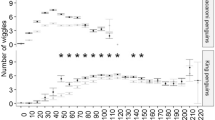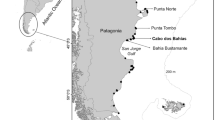Abstract
For oceanic birds like king penguins, a major constraint is the separation of foraging areas from the breeding colony, largely because swimming increases foraging costs. However, the relationship between foraging strategy and breeding stage has been poorly investigated. Using time-depth recorders, we studied the diving behaviour of two groups of king penguins that were either incubating or brooding chicks at Crozet Islands (Southern Indian Ocean) at the same period of the year. Although birds with chicks had the highest predicted energy demand, they made foraging trips half as long as incubating birds (6 vs. 14 days) and modified their time and depth utilisation. Birds with chicks dived deeper during daylight (mean maximum depth of 280 m vs. 205 m for those incubating). At night, birds with chicks spent twice as much time diving as those incubating, but birds at both stages never dived beyond 30 m. Movements to greater depths by brooding birds are consistent with the vertical distribution of myctophid fish which are the main prey. As chick provisioning limits trip duration, it is suggested that it is more efficient for parents to change their diving patterns rather than to restrict their foraging range.
Similar content being viewed by others
Author information
Authors and Affiliations
Additional information
Received: 23 June 1997 / Accepted: 3 November 1997
Rights and permissions
About this article
Cite this article
Charrassin, JB., Bost, C., Pütz, K. et al. Foraging strategies of incubating and brooding king penguins Aptenodytes patagonicus . Oecologia 114, 194–201 (1998). https://doi.org/10.1007/s004420050436
Issue Date:
DOI: https://doi.org/10.1007/s004420050436




